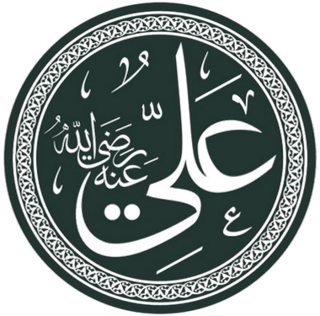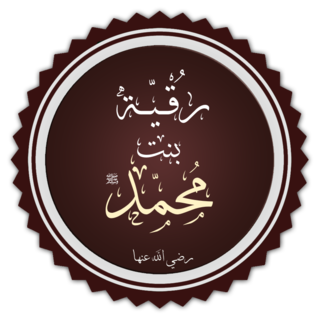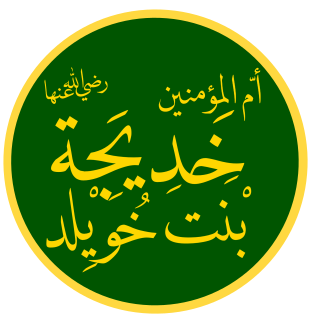Related Research Articles

Zayd ibn ʿAlī, also spelled Zaid, was the son of Ali ibn Husayn, and great-grandson of Ali. He led an unsuccessful revolt against the Umayyad Caliphate, in which he died. The event gave rise to the Zaidiyyah sect of Shia Islam, which holds him as the next Imam after Ali ibn Husayn. Zayd ibn Ali is also seen as a major religious figure by many Sunnis and was supported by the prominent Sunni jurist, Abu Hanifa, who issued a fatwa in support of Zayd against the Ummayids.

The Rashidun Caliphs, often simply called, collectively, "the Rashidun", are, in Sunni Islam, the first four caliphs (successors) following the death of the Islamic prophet Muhammad, namely: Abu Bakr, Omar, Uthman ibn Affan, and Ali of the Rashidun Caliphate (632–661), the first caliphate. The fifth caliph, Hasan ibn Ali, is sometimes also considered to be Rashidun as well, but since he ruled for merely a six month period, he is not mentioned categorically. It is a reference to the Sunni imperative "Hold firmly to my example (sunnah) and that of the Rightly Guided Caliphs".

Jannat al-Baqīʿ is the oldest and the first Islamic cemetery of Medina in the Hejazi region of present-day Saudi Arabia. It is located to the southeast of the Prophet's Mosque, which contains the graves of some of the Islamic prophet Muhammad's family and friends. It is also known as Baqīʿ al-Gharqad.

Safiyyah bint Huyayy, was one of the wives of the Islamic Prophet Muhammad. She was, along with all other wives of Muhammad, titled Umm-ul-Mu'mineen or the "Mother of Believers".
This is a timeline of major events in the Muslim world from 601 AD to 700 AD.

Qasim ibn Muhammad was the eldest of the sons of Muhammad and Khadija bint Khuwaylid. He died in 601 CE, after his third birthday and is buried in Jannat al-Mu'alla cemetery, Mecca, Saudi Arabia.

Alī ibn Abī Ṭālib was an early Islamic leader. Ali is revered by Sunni Muslims as the fourth Rightly Guided Caliphs, and as a foremost religious authority on the Qur'an and Fiqh. Shi'a Muslims consider him the First Imam appointed by the Islamic prophet Muhammad and the first rightful caliph. Ali was the cousin of Muhammad, and after marriage to Fatimah he also became Muhammad's son-in-law.

Zayd ibn Harithah, was an early Muslim, sahabah and the adopted son of the Islamic prophet, Muhammad.

Ruqayyah bint Muhammad was one of the daughter of the Islamic prophet Muhammad and Khadija.

Ahl al-Bayt primarily refers to the family of the Islamic prophet Muhammad, and, to a lesser extent, his ancestor and the Islamic prophet Ibrahim (Abraham).

Zainab bint Muhammad was the eldest daughter of the Islamic prophet Muhammad by his first wife Khadijah.
The timing of the Sahabah becoming Muslims is of importance in the History of Islam. It has been widely covered in various books of Seerah - historical biographies of the Prophet.
The Muhajirun were the first converts to Islam and the Islamic prophet Muhammad's advisors and relatives, who emigrated with him from Mecca to Medina, the event known in Islam as the Hijra. The early Muslims from Medina are called the Ansar ("helpers").

Muhammad, the final Islamic prophet, was born and lived in Mecca for the first 53 years of his life until the Hijra. This period of his life is characterized by his proclamation of prophethood. Muhammad's father, Abdullah ibn Abd al-Muttalib, died before he was born. His mother would raise him until he was 6 years old, before her death around 577 CE at Abwa'. Subsequently raised by his grandfather, Abd al-Muttalib, and then his uncle, Abu Talib ibn ‘Abd al-Muttalib, Muhammad's early career involved being a shepherd and merchant. Muhammad married Khadija bint Khuwaylid after a successful trading endeavour in Syria. After the death of Khadija and Abu Talib in the Year of Sorrow, Muhammad married Sawda bint Zam'a and Aisha.
The Ashraf are persons descended from Muhammad by way of his daughter Fatimah. The word with long ā in the second system, is the plural of sharīf "noble", from sharafa "to be highborn", but ašhraf, with short a, is the elative of sharīf meaning "very noble", "nobler", "noblest".

Khadija bint Khuwaylid, commonly known as Khadija, was the first wife and first follower of the Islamic prophet Muhammad. Khadija was the daughter of Khuwaylid ibn Asad, a leader of the Quraysh tribe in Mecca, and a successful businesswoman in her own right.

Abū Saʿīd Ḥasan ibn Yasār al-Baṣrī, often referred to as Ḥasan of Basra for short, or reverentially as Imam Ḥasan al-Baṣrī in Sunni Islam, was an early Muslim preacher, ascetic, theologian, exegete, scholar, judge, and mystic. Born in Medina in 642, Hasan belonged to the second generation of Muslims, all of whom would subsequently be referred to as the tābiʿūn in Sunni Islamic piety. In fact, Hasan rose to become one of "the most celebrated" of the tābiʿūn, enjoying an "acclaimed scholarly career and an even more remarkable posthumous legacy in Islamic scholarship."

Kulthum bint Muhammad, also known as Umm Kulthum was the third daughter of the Islamic prophet Muhammad by his first wife Khadijah bint Khuwaylid. She was also the wife of Uthman, the Third Caliph of the Rashidun Caliphate.
Affan ibn Abi al-As is the father of a Sahabi.

The children of Muhammad include the 3 sons and 4 daughters, born to the Islamic prophet Muhammad. All were born to Muhammad's first wife Khadija bint Khuwaylid except one son, who was born to Maria al-Qibtiyya.
References
- 1 2 Al-Tijani in his The Shi'ah are (the real) Ahl al-Sunnah on Al-Islam.org note 274
- ↑ Quran 33:04
- 1 2 anwary-islam.com Archived 2006-06-15 at the Wayback Machine
- ↑ The Arabic language has three persons - singular, dual, and plural, with the latter referring to more than two. For further explanation, refer to Arabic grammar.
- ↑ Quran 33:59
- ↑ @ Al-Islam.ORG
- ↑ Mubahala (Imprecation) @ ezsoftech.com